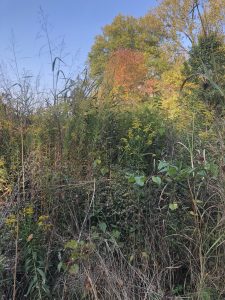
West: Canadian Golden Rod and Field Grasses photographed at Sit Spot. This is where Honey Bee was observed.
“In nature nothing exists alone.” – Rachel Carson, Silent Spring
It turns out if you are looking for a bit of silence nature is not the best place to seek it out. October 6th, at 4:23 p.m. I was sitting on a yoga mat staring at trees and being bombarded by an absolute cacophony of sounds. Wind was blowing harshly through the tree canopy. Bees, wasps, and grasshoppers darting through the air. Birds calling to one another. A dog barking somewhere off in the distance. It is far from silent.
The noise creates a buffer from the rest of the world; like a layer of molasses, warm and thick. I’m not too far from a well-traveled road, but I do not hear a single car. The tall trees wall you in protectively. Even though I can see the wind ripping through the tops of the trees, I do not feel it against my skin. It is cooler where I sit, too. The trees are tall enough and thick enough that at certain times of the day you are ensconced in shadow.
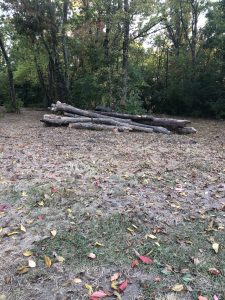
Eastern View before removal of downed trees.
A part of me feels vulnerable here. While I can hear almost everything, the vegetation hides a lot from view which leaves me with the feeling of eyes watching me. It is easy to let your mind wander to the bigger animals that might be lurking in the tree line. Liberty Township does have a population of coyotes running around.
This place, like many, has not been spared from the influence of humankind. Trees were felled, piled up, then dragged away. Tall grasses were mowed down and flowers bulldozed over. The felled trees I was planning on observing the stages of rot in were taken away by a pickup truck, if the tire marks are any indication. They took the unidentified plant that had been growing underneath with them. They left the walnuts, though!
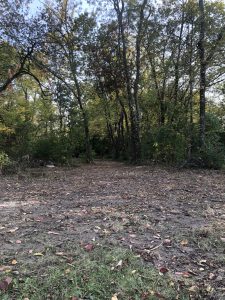
Eastern View after removal of downed trees.
My last visit to this spot left me a bit perplexed. Ohio is home to quite a few native trees (sadly, some invasive species also) and, yet, all there seemed to be in this area were Black Walnut Trees and some shrubbery. This is no mere coincidence. After some research, I learned that Black Walnut Trees are highly competitive and can/will kill other trees nearby. They do this either by monopolizing light, water, and nutrients or through their natural production of juglone.
Juglone is labeled as an acute toxin, irritant, and environmental hazard by the NIH. This is an organic compound that exists as a solid and is slightly water soluble. Juglone occurs naturally throughout the entire Black Walnut Tree. It is in the roots, the leaves, and the falling fruits. This compound is released into soil extending as far as the roots and tree drip. In some cases, this could be a 50 foot radius.
The southern tree line at my sit spot is mainly black walnut trees and the creek bed in the east is lined with them. This means over time it is more likely that there will continue to be a copious amount of Black Walnut Trees than not. Seeing as: 1) they monopolize water and nutrient supply 2) they produce a natural herbicide (juglone) and 3) they produce large amounts of fruiting bodies.
Let’s take this one step further. I decided to take some soil samples while at my sit spot today. I collected a total of four samples: one from the edge of the creek in the east, one from the northern tree line, one from the southern tree line, and one from the field grasses in the west. My purpose was to test the soil’s pH levels and look for differences in pH based on location. Initially, my focus was on proximity to water. However, after my test results came back and I had completed some research on Black Walnut Trees, I was driven in a different direction.

http://texastreeid.tamu.edu/images/TreeImages/walnut_black150.jpg Not my photo. Credit goes to Texas AM.
The northern tree line naturally lacks Black Walnut Trees. Instead, it is populated by a couple of Hackberry trees that I learned are sensitive to Juglone. In this area, the soil is slightly acidic roughly 6.5. I find it important to note that I am aware Juglone is a slightly acidic compound, but the health and size of the Hackberry trees denotes any juglone being located in the soil here.
Comparatively, the soil at the creek bed and at the southern tree line, where Black Walnut Trees are in abundance, has more alkaline soil. The creek soil pH was greater than 7.5 whereas, the northern tree line soil had a pH roughly 7.2.
Juglone is not very water soluble, but can become more soluble in alkaline conditions. In addition, the soil underneath Black Walnut Tree canopies can be up to 0.7 pH lower than the soil elsewhere. So, what exactly is happening here? Juglone can take time to degrade even in more alkaline environments. What ends up happening is a very effective double-whammy. If the toxicity of the Juglone is not enough to kill a plant then the lowering of the pH is. These trees are serious when they say you can’t sit with them.
- Honey Bee on Calico Aster
- Honey Bee on Prairie Fleabane
The discoveries don’t end there. Most people are familiar with how bees are disappearing at an alarming rate. I was ecstatic to see seemingly so many in one place. I did my best to follow one bee in particular. This specimen had a very fuzzy orange body of a comparatively medium size and lacked striping typically seen.
It started on a thatch of Canadian Goldenrod (I have decided to follow this plant since the other was removed) six feet from my sit-spot. I did have to stand up to get a better look at it. It would crawl from one grouping of flowers to another becoming covered in a light dusting of pollen. It then flew to a Calico Aster, a dying Cone-Flower, and a Red Clover. As it moved from plant to plant, the bee seemed to avoid bees or wasps that didn’t resemble it. This did cause me to wonder what the different types were that I was observing.
According to The Ohio State College of Food, Agriculture, and Environmental Sciences, the bee I described earlier was a Honey Bee or Apis mellifera. They are identifiable by their light brown bodies, heart-shaped heads, and hairy eyes. Yes, they have hair on their eyes. The Honey Bees were out-numbered by other species, such as: the Common Eastern Bumble Bee (Bombus impatiens), the Eastern Yellow Jacket (Vespula maculifrons), and the Northern Paper Wasp (Polistes fuscatus). The Eastern Yellow Jacket I managed to photograph (without being stung) happens to be a male. This species displays sexual dimorphism which makes telling the two sexes apart easier. The male is larger than normal females, but smaller than queens. He is also more yellow than orange with more stripes. Fun fact: Male bees mainly serve a reproductive purpose and, thus, lack a stinger!
- Purple Coneflower
- Common Chicory
- New England Aster
Another thing lacking right now, is some rain. October is typically the driest month in Ohio (driest, not dry). The soil, consisting mostly of clay, is rather dry at the moment. Thankfully, decreasing temperatures has slowed the loss of water through evaporation and plants aren’t suffering quite yet. However, waterways are taking a hit. The creek bed I have been referencing is actually a part of the Great Miami River watershed which is an important waterway that feeds into the Ohio River which feeds into the Mississippi River. This is very important!
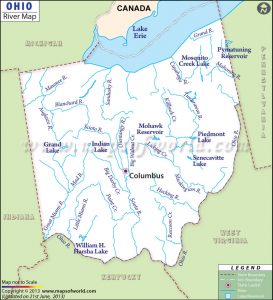
Map of Ohio Rivers. Not my photo. https://www.mapsofworld.com/usa/states/ohio/ohio-river-map.html. Credit to Maps of World.
Right now this creek is stagnant. Either there isn’t enough rain or a blockage that is preventing flow. I would like to be able to run some tests on the water in order to study run-off from my neighbors lawns. Whatever is getting dumped in the water at Liberty Township will be more detrimental to those who live downstream. For example, it is highly advised that no one swim or eat fish from the Ohio River due to extreme water pollution.
Nice, suburban neighborhoods are not exempt from littering or water pollution. One of the most appalling things about visiting these places in nature is seeing all the trash and construction rubble left there. It only takes a moment to pick something up and put it in a trashcan provided at the entrance of the park. Nature did not ask for us to leave garbage in her beautiful places. I’ve decided that the next time I visit I will bring a bag to collect trash. Clearing out even one bag can make a huge difference for the wildlife in that area.
Sources:
“Are Black Walnut Trees Bad for Gardens?” UNH Extension, 6 Nov. 2019, extension.unh.edu/blog/are-black-walnut-trees-bad-gardens. Accessed 7 Oct. 2020.
Eaton, Eric, and Ohio Department of Natural Resources: Division of Wildlife. “Common Bees and Wasps of Ohio Field Guide.” Mar. 2016.
Ellsworth, Denise. “Bumble Bees in Ohio: Natural History and Identification of Common Species.” Ohioline.Osu.Edu, ohioline.osu.edu/factsheet/ent-84. Accessed 7 Oct. 2020.
Feeley, Chris. “Black Walnut: The Killer Tree.” News, www.extension.iastate.edu/news/2005/jul/070701.htm. Accessed 7 Oct. 2020.
Ohio Department of Natural Resources: Division of Wildlife. “Trees of Ohio: Field Guide.” Ohio DNR, Feb. 2016, ohiodnr.gov/wps/wcm/connect/gov/75213562-401d-4129-86bd-c9197f766b71/Pub+5509+Trees+of+Ohio+WEB.pdf?MOD=AJPERES&CONVERT_TO=url&CACHEID=ROOTWORKSPACE.Z18_M1HGGIK0N0JO00QO9DDDDM3000-75213562-401d-4129-86bd-c9197f766b71-na6vMOm. Accessed 6 Oct. 2020.
Prajzner, Scott, and Mary Gardiner. “Ohio Bee Identification Guide.” Ohioline.Osu.Edu, ohioline.osu.edu/factsheet/ENT-57. Accessed 7 Oct. 2020.
PubChem. “Juglone.” Pubchem.Ncbi.Nlm.Nih.Gov, pubchem.ncbi.nlm.nih.gov/compound/juglone#section=NLM-Curated-PubMed-Citations. Accessed 7 Oct. 2020.
Rasool Hama, Jawameer. “Toxin of the Week.” Natoxaq.Ku.Dk, 8 Oct. 2018, natoxaq.ku.dk/toxin-of-the-week. Accessed 7 Oct. 2020.

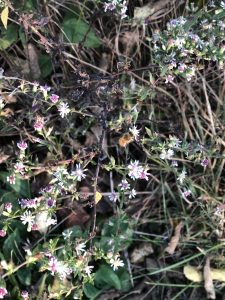


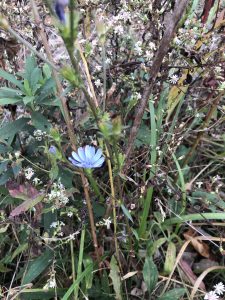

This blog is extremely impressive; I learned so much! Your post is visually well formatted, and your writing, analysis, and sources are very compelling. I am eager to hear about the results from your water tests if you do end up doing them.
I love your blog post title!!!! And then the quote…and then the work – GREAT JOB KYRA! Thank you this was a pleasure to read!
I lack an adjective to describe this piece. Kyra, you are an Ecologist, a researcher and a great writer! That was a captivating introduction. Thanks for making me learn something new (Juglone). It’s good you could focus on honey bees. As for me, when I saw one, it disappeared before I could think of watching it.
I have a question and if you respond, I will know you have seen this comment.
While you were concentrating on the bees, did you hear any buzzing sounds?
There was hundreds of buzzing sounds. While I am not sure if honey bees swarm so late in the season, I can definitely tell you that some of that buzzing was actually from grasshoppers and locusts.